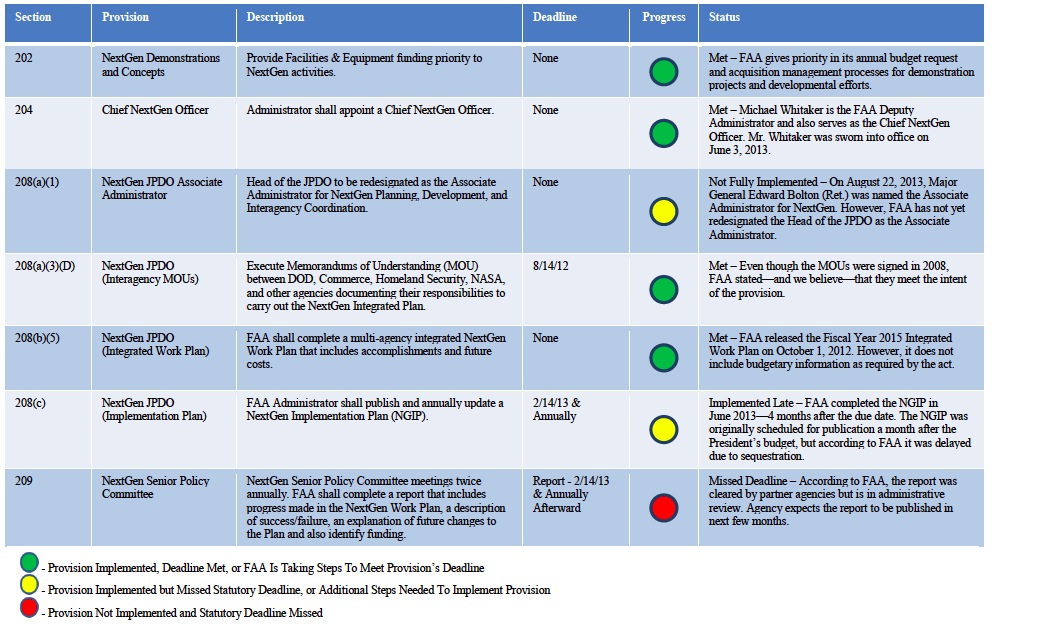UNITED STATES DEPARTMENT OF TRANSPORTATION
OFFICE OF THE INSPECTOR GENERAL
The Next Generation Air Transportation System (NextGen) is a critical infrastructure project that will transform the Nation’s air traffic management from ground-based radar to a satellite-based system with the goals of improving safety, meeting the expected demands for increased capacity, and improving efficiency. It is also FAA’s most complex modernization effort to date and will require multibillion-dollar investments from both the Federal Government and airspace users to successfully implement. However, since its inception a decade ago, FAA’s progress in implementing NextGen has not met the expectations of Congress and industry stakeholders, and key modernization efforts have experienced significant cost increases and schedule delays.
On February 14, 2012, the FAA Modernization and Reform Act of 2012 (the act) was signed into law. Title II of the act included several provisions intended to help FAA better manage NextGen, provide more accountability, and advance the implementation of new air traffic procedures and technologies. However, there were concerns with FAA’s ability to meet these goals after a September 2012 House Aviation Subcommittee hearing highlighted significant cost overruns and program delays with key NextGen initiatives and modernization projects.
Following the hearing, the leadership of the House Committee on Transportation and Infrastructure and its Subcommittee on Aviation requested that we assess FAA’s progress in implementing the act’s NextGen-related requirements. Accordingly, our objectives were to (1) assess FAA’s progress in meeting the NextGen provisions prescribed in the FAA Modernization and Reform Act of 2012 and (2) identify the challenges that may prevent FAA from meeting the provisions of the act. On September 17, 2013, we provided a letter to the Chairman of the House Transportation and Infrastructure Committee and the Chairman and Ranking Member of the House Aviation Subcommittee that summarized FAA’s actions to address Title II requirements. We also explained several ongoing challenges that may hinder the Agency’s ability to fully address the act’s provisions. This report provides the full results of our review.
We conducted this performance audit in accordance with generally accepted Government auditing standards. Exhibit A details our scope and methodology, and exhibit B lists the organizations we visited or contacted.
RESULTS IN BRIEF
As of August 2013, FAA implemented or is on target to implement 11 of the 24 NextGen provisions that we identified in Title II of the act, including appointing a Chief NextGen Officer and completing a multi-agency NextGen Integrated Work Plan. However, FAA has not implemented other key provisions intended to accelerate NextGen technologies, such as initiating rulemaking activities requiring use of the Automated Dependent Surveillance-Broadcast (ADS-B) In system for enhanced satellite-based air traffic surveillance. Moreover, FAA is behind schedule on many of the act’s deadlines for reports and plans related to determining NextGen progress, such as reports explaining the requirements for using performance-based navigation at the Nation’s airports.
FAA’s difficulties in meeting the act’s provisions stem from longstanding programmatic and organizational challenges, including the technical complexity of NextGen initiatives; the collaboration required with other Government and aviation stakeholders to complete the initiatives; and financial concerns, such as meeting the provisions of the Budget Control Act of 2011. Given the importance and complexity of the act’s provisions in advancing NextGen technologies and that FAA implemented less than half of them, keeping decisionmakers and stakeholders informed of the Agency’s progress is key. However, FAA has not developed a process to regularly update stakeholders on its status in meeting the act’s provisions, including setting priorities and revised target action dates for missed deadlines.
We are making recommendations to FAA to better assist the Agency in meeting the act’s Title II provisions and keeping stakeholders informed of progress.
BACKGROUND
The United States air transportation system serves approximately 730 million passengers each year and nearly 70,000 flights occur each day in U.S. airspace. FAA expects significant increases in commercial and general aviation activity over the next decade that will result in 1 billion passengers traveling per year and more than 79,000 flights per day by 2025. A critical component that will enable FAA to successfully manage this projected surge in air traffic is the advancement and implementation of NextGen technologies.
FAA spends nearly $1 billion annually on NextGen efforts. We have reported on cost and schedule risks with NextGen programs as well as challenges that FAA must address to successfully transition from the legacy air traffic systems to NextGen since the program began in 2004. For example, we testified in July 20097 that organizational barriers and fragmented initiatives hindered FAA’s process for approving new flight procedures. During a September 2012 hearing, we reiterated similar concerns regarding FAA’s ability to implement NextGen capabilities that could result in delayed benefits. Moreover, our prior work on NextGen programs indicates that the Agency has had difficulties coordinating those efforts.
About the USDOT Office of the Inspector General
oig.dot.gov
“The Office of Inspector General is committed to fulfilling its statutory responsibilities and supporting members of Congress, the Secretary, senior Department officials, and the public in achieving a safe, efficient, and effective transportation system.”
Tags: airports, flight, Next Generation Air Transportation System, NextGen, Office of the Inspector General, United States Department of Transportation, USDOT







 RSS Feed
RSS Feed